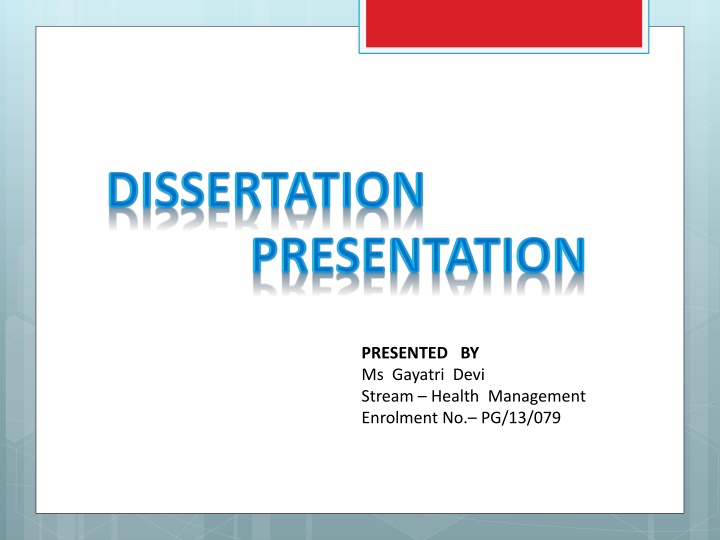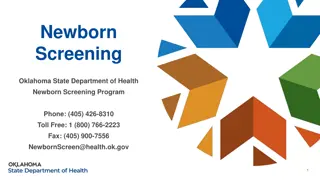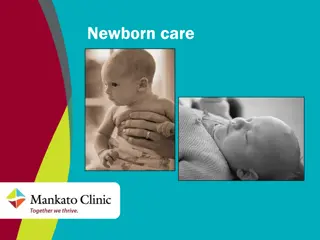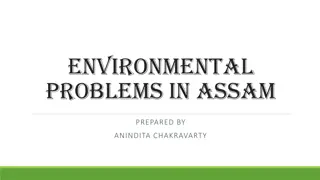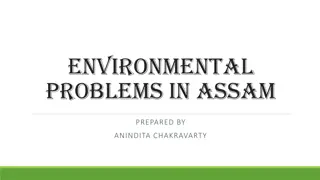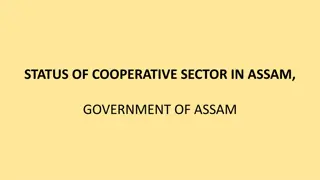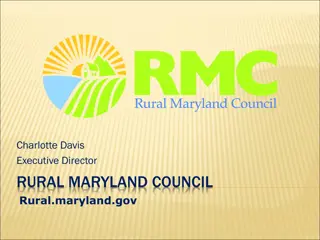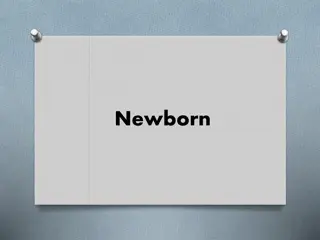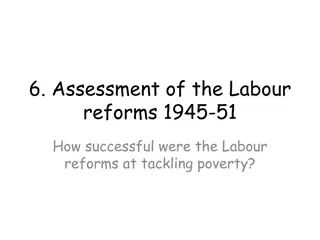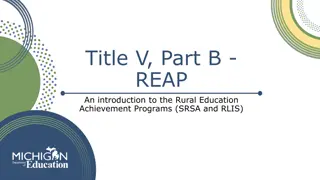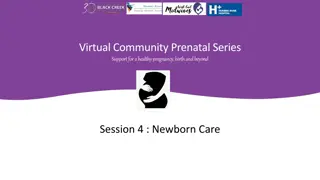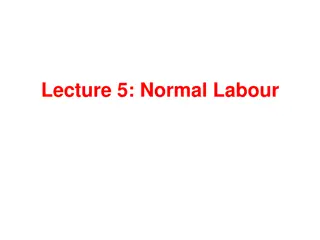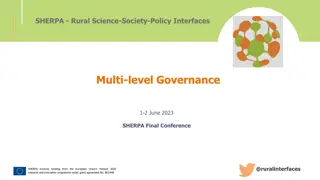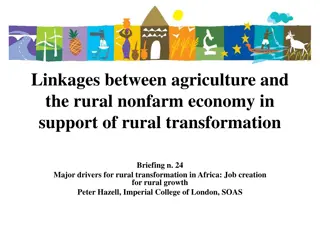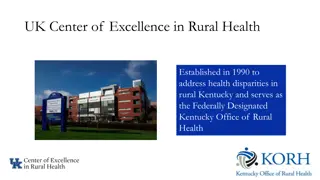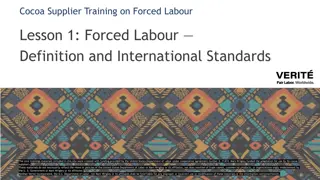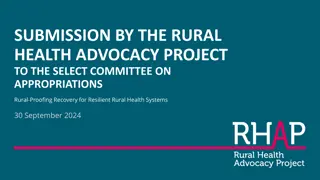Assessment of Labour Room and Newborn Care in Kamrup Rural District, Assam
Ms. Gayatri Devi presents a study on evaluating the status of labour rooms and newborn care corners in public health facilities in Kamrup Rural District. The aim is to assess the existing conditions and propose improvements for better maternal and newborn healthcare services.
Download Presentation

Please find below an Image/Link to download the presentation.
The content on the website is provided AS IS for your information and personal use only. It may not be sold, licensed, or shared on other websites without obtaining consent from the author.If you encounter any issues during the download, it is possible that the publisher has removed the file from their server.
You are allowed to download the files provided on this website for personal or commercial use, subject to the condition that they are used lawfully. All files are the property of their respective owners.
The content on the website is provided AS IS for your information and personal use only. It may not be sold, licensed, or shared on other websites without obtaining consent from the author.
E N D
Presentation Transcript
PRESENTED BY Ms Gayatri Devi Stream Health Management Enrolment No. PG/13/079
STUDY TITLE ASSESSMENT OF EXISTING STATUS OF LABOUR ROOM AND NEWBORN CARE CORNER IN PUBLIC HEALTH FACILITIES IN KAMRUP RURAL DISTRICT OF ASSAM
OUTLINE OF PRESENTATION Introduction of the study topic Review of literature Methodology Result Discussion Conclusion & Recommendations
Problem statement Objectives of the study Hypothesis Research variables Demographic variables
Problem Statement India s contribution to global neonatal death is 27% Around 36% of all neonatal deaths occur within the first 24 hours Intra - partumperiod and the first 24 hours of postpartum period contribute to 46% of maternal death In Assam, high maternal mortality continues to be a cause for concern despite investment from Central and State government The current MMR of Assam is 328 (SRS, 2011-12).
Continues. National Rural Health Mission (NRHM) aims To deliver . quality health care for safe motherhood and child survival Through ..operationalization of 24X7 PHCs and designated FRU By providing .BEmOC and Comprehensive emergency obstetric and child health services close to the client s home 24x7 .
Continues. NRHM emphasizes towards improvement in health Areas of basic Intervention care infrastructure in EAG states Though RCH Project of Govt. of India has stipulated norms for each health facility Assam has weak public health indicators and / or weak infrastructure Itis still grappling with scarcity of adequate infrastructure and human resources.
Continues. Areas of basic Intervention Facility survey is envisaged as an important activity to assess the existing status of health institutions NRHM has developed IPHS standards which sets minimum standards for all level of facilities.
Continues The present study aimed To examine opportunities for strengthening intra - partum care at the public health facilities By exploring the current status of rural primary care model of labour rooms in Assam.
Study objectives General objective: To assess the existing status of labour rooms in public health facilities as per IPHS guidelines and standard laid down in the MNH Toolkit
Continues Specific objectives: To assess the availability of infrastructure, human resource and training, equipments, drugs and surgical items, other miscellaneous items along with service delivery and recording system in Labour Room and NBCC of different levels of health facilities in Kamrup (R)
Continues To assess the knowledge understand regarding standard measures to be followed in Labour room among the key staff members To assess the compliance to quality standard To suggest measures for the enhancement of functioning of the Labour room.
Hypothesis Areas of basic Intervention H0: The labour room & NBCC of public health institutions do not fulfil the criteria as per IPHS and MNH Toolkit H0: There is no awareness regarding standard measures to be followed in Labour room among key staff members H0: The Labour room of public health facilities are not fully compliance as per the standards of IPHS and MNH Toolkit.
Study Variables Research variables: Standard and knowledge Demographic variables: Age, sex, education/ level of training, professions, years of experience.
REVIEW OF LITERATURE
ROL -1 Advent Health Care Group conducted a facility survey in Assam for the Mission Director of NRHM, Assam in 2007. The study was conducted across 24 districts covering a total 5,425 health centres including PHC, CHC, MPHC, SD and SC. The questionnaires used in the study were developed on the basis of IPHS format although some modifications were made to the IPHS format to suit the state s specific requirements. The study found that most of the CHCs have all necessary infrastructure and furniture like delivery table, saline stand; 94.1% of CHCs have Labour room.
ROL-1 Continues Among Block PHC only 41.9 % has 24x7 delivery services, 96% of BPHC has at least one medical officer out of which 79% has 2 or more medical officers, 63% of BPHC has at least one staff nurse while 28.2% centres have 3 or more staff nurses to provide 24 hours service. Labour rooms are available in 84.6 percent of BPHCs and labour table are available in 93.2 percent facilities. Among basic equipment and instruments, BP instrument is available in 87.8 percent BPHCs where as stethoscope is only 55.4 percent, Infant weighting machines are available in only 79.7 percent BPHCs.
ROL-1 Continues Only 17% of MPHC provide 24 hours delivery services. Labour tables are available in 51.8%, the availability of electricity (39.1%) and power back up facility (3.2%) is very low. No district in Assam has adequate number of essential newborn care equipments such as resuscitation bag, radiant warmer and phototherapy unit. Among SD only 20% has 24 hours delivery service. Nearly 85 percent of SDs in the state has at least a medical officer. The ones not having a medical officer is either manned by an AYUSH doctor or a pharmacist
ROL-1 Continues Nearly 42.7% SD has labour room and 52.8% has labour table. Basic infrastructure facilities like water supply, power backup (generator) are required by almost 95 percent of the SDs. However, no district in Assam has adequate number of essential newborn care equipments like Infant resuscitation bag, Radiant warmer and Photo therapy unit.
ROL-2 Thakor Nilesh et al conducted a cross sectional study on Quality assessment of facilities available at Primary Health Care Centres in Rajkot District . The objective of the study was to assess the quality of facilities available at primary health care centres as per IPHS guidelines. The study was conducted in 14 PHCs randomly selected, 2 from 7 blocks of Rajkot district. Pretested close ended questionnaire was used. The facility was assessed according to IPHS guidelines.
ROL-2 Continues The study revealed that 50% PHCs was located within the village area and 28% was within 1 KM from village; Doctor, Nurse, lab-technician and Pharmacist is available in 92%, 57%, 100% and 100% PHCs respectively. Residential facility is available in 21% of PHCs. More than 85% of Doctors, staff nurses and health worker are trained for IMNCI and ANC services. The study recommended that incentives should be given to work at remote places and all the post of staff should be filled up as early as possible.
ROL-3 Sodani Rai Prahlad et al conducted a study on Assessing Indian Public Health Standards for 24x7 Primary Health Centres: A case study with special reference to newborn care services . The main objective of the present study is to identify the existing gap with respect to Indian Public Health Standards (IPHS) for availability of infrastructure, human resources, investigative services and essential newborn care services at 24 7 primary health centres (PHCs) of Bharatpur district of Rajasthan state. All the 19 PHCs were selected for the study.
ROL-3 Continues Data were collected from medical officer in - charge from the study 24 7 PHCs to provide required data on infrastructure, human resources, investigative services and newborn health care services through the well structured questionnaire. It was found that the availability of operation theatre, telephone and E - mail facility were not satisfactory. Labour room was available at almost all the 24 7 PHCs while nearly 75% of the 24 7 PHCs have laboratory and cold chain facility. Shortage of human resources, especially laboratory technician and pharmacist were observed.
ROL-3 Continues It was also observed that none of the 24 7 PHCs have fully equipped newborn corner. The study concluded that the availability of human resources, infrastructure and facilities for newborn care services at the 24 7 PHCs were not satisfactory as per the prescribed IPHS. Efforts are required on priority to strengthen OT, investigative facilities and communication facilities at the 24 7 PHCs. It is recommended that availability of pharmacist/compounder shall be as per IPHS norms at the 24 7 PHCs. New born care corners established at 24 7 PHCs should be provided adequate equipment/items as recommended by the IPHS so as to become effective and functional to provide newborn care services in the rural areas.
Study Design An exploratory quantitative study design was adopted In the study district Kamrup Rural, there are 12 Block PHC, 27 MPHC and 22 SD The study covered 4 Block PHCs out of which 3 serves as CHC/FRU, 3 Mini PHCs and 3 SD A total of 10 health centres were selected randomly to cover under the study. For the interview of key staff members 30 samples were selected conveniently.
Study Area:Kamrup Rural district of the state Assam Data collection technique: Data was collected by observation, record review and interview method Data collection period: The data was collected for a period of 2 weeks (6th to 22 April, 2015). Study Tool: Semi-structured checklist & Semi- structured questionnaires.
Data analysis: Collectedquantitative data were entered in SPSS version 16.0 and analysed using Excel worksheet. Data were analysed calculating average percentage. Challenges faced : Delay in getting approval for the facility visit from the Joint Directorate office Untimely rains & weak transportation Non-availability of staff due to long Bihu festival.
Limitations of the study: The health centres spread across the study district, because of difficult terrain & closing of some of the facility at 1.30 pm the researcher had to shorten the interview period Many a time staff nurses were unaware regarding availability of labour room equipments
Had to wait for long hours to get the data due to unavailability or busy schedule of the data manager A common pro-forma was used for collecting data which was based on the IPHS document and MNH Toolkit. The pro-forma needed more customization.
Expected outcome of the study: The study provided new insight for researchers and hospital managers Ethical clearance: Approval for the study was obtained from the concerned authority, all interviews were conducted after obtaining verbal consent of the subject.
List of BPHCs and its corresponding MPHCs & SDs covered under the study Name of BPHC Name of PHC Boko BPHC/CHC/FRU Deochar MPHC Tarabari SD Kamalpur BPHC/CHC/FRU Dorakohora SD Puthimari MPHC North Guwahati BPHC Changsari SD Suktaguri MPHC Sualkuchi BPHC -----
Categorization of the selected health facilities in to L1, L2 & L3 levels as per guidelines of MNH Toolkit Sl. No L3 (FRU/CHC) L2 (24x7 PHC/Non FRU CHC) L1 (SC/Non 24X7 PHC) 1 Boko BPHC/CHC/FRU North -Guwahati BPHC Tarabari SD 2 Kamalpur BPHC/CHC/FRU Changsari SD Dorakohora SD 3 Sualkuchi BPHC Deochar MPHC Puthimari MPHC 4 . . Suktaguri MPHC Tota l 3 3 4
Distribution of health facilities by availability of infrastructure as per IPHS(n=8) Monitoring parameters Percentage of health facilities(n%) Without water leakage/ Dampness from the room 87.5 Intact door and windows with panes 100 Curtain and side screen between Labour tables 62.5 Clean Labour Room 62.5 Washbasin inside Labour Room with running water and soap 87.5 Wash basin with elbow tap 0
Continues Attached Toilet with Labour Room 87.5 Clean toilet and running water supply 62.5 Power Supply in Labour Room Backup power supply ( Generator or Inverter) Functional fan, Bulb, Tube within Labour Room 100 62.5 100 Functional room heater for winter 25 High capacity torch with rechargeable cells 62.5
Distribution of health facilities by availability of Equipments & Accessories in Labour room Monitoring parameters Labour table with mattress, sheet, Macintosh, Foot-rest, Kelly's pad Suction Machine (Electrical / Foot operated) Mobile lamp with stand Percentage of health facilities 50 37.5 12.5 Watch/ clock with second hand 50 Delivery tray Episiotomy tray Medicine tray Emergency drug tray 75 75 25 25 Baby tray MVA tray 75 0
Continues Stethoscope 100 75 Foeto-scope BP apparatus Weighing machine for newborn (Preferably Digital ) Thermometer (Digital) Measuring Tape 100 100 50 25 Stretcher with trolley 50 Wheel Chair Focused lighting Stool for birth companion Autoclave drums 62.5 62.5 37.5 75
Continues Electrical sterilizer Refrigerator Pulse oxymeter Oxygen cylinder with flow meter tube + Mask + Wrench 50 0 12.5 62.5 Partograph Coloured bin for bio medical waste management (RED) 25 62.5 Coloured bin for bio medical waste management YELLOW) 87.5 Coloured bin for bio medical waste management (BLUE) 62.5 Hub cutter Puncture proof container 12.5 0
Distribution of health facilities by availability of Equipments & Accessories in NBCC Monitoring parameters Percentage of health facilities 75 Radiant Warmer Phototherapy unit 25 Baby Scale Oxygen hood (Neonatal) 75 25 Mucus extractor with suction tube and a foot operated suction machine NG tubes 62.5 AMBU bag ( Size- 0 and 1) / Bag & Mask 87.5 Feeding tubes (Nasogastric tube) 50 Laryngoscope and Endotracheal intubation tubes 25
Distribution of health facilities by availability of Human Resource Human Resource MNH Toolkit Minimum requirement as per Facilities fulfilling the norms L3 L2 L1 L3 No. % 3 L2 No. % L1 No. % Medical officer(MBBS) *4 1 to 2(on call after OPD hours) NE 100 1 33.3 1 50 Paediatrician 1 NE NE 2 66.7 NE NE NE NE Obstetric & Gynaecology specialist 1 NE NE 3 100 NE NE NE NE *As per case load, for <100 deliveries/ month requirement of MO is 1-2; for 100-200 deliveries/month requirement of MO is 4. NE: Not essential)
Continues Human Resource Minimum requirement as per MNH Toolkit L3 L2 Facilities fulfilling the norms L1 L3 No. % 3 L2 No. % L1 No. % NE Anaesthetist 1 NE NE 100 NE NE NE Staff Nurse 4 2 NE 3 100 2 66.7 NE NE ANM 4 2 2 2 66.7 1 33.3 1 50 Laboratory Technician 2 2 1 3 100 1 33.3 2 100 Counsellor/ Health educator 1 1 1 3 100 0 0 0 0 Cleaner 4 3 1 0 0 0 0 0 0
Distribution of health facilities by training status of HR Type of training No. of staff trained L3 No. L2 L1 No. % No % % MO trained with BEmOC MO trained with FIMNCI MO trained with NSSK SBA trained SN SBA trained ANM NSSK trained SN NSSK Trained ANM FIMNCI trained SN 0 1 3 3 0 2 1 1 0 33.3 100 100 0 66.7 33.3 33.3 0 0 1 0 1 1 1 1 0 0 33.3 0 33.3 33.3 33.3 33.3 NE NE NE 1 2 1 2 NE NE NE NE 50 100 50 100 NE NE : Not essential
Distribution of health facilities by equipments available in Delivery Tray % of availability 100 100 100 100 100 100 100 100 87.5 87.5 87.5 75 75 50 50 50 37.5
Distribution of health facilities by availability of Essential Drugs % of availability 100 100 100 87.5 87.5 75 75 75 65 62.5 62.5 62.5 50 50 37.5 25 25 25
Distribution of L3 & L2 facilities by availability of Emergency Drugs %of availability 66.7 50 50 50 50 33.3 33.3 33.3 33.3 33.3 16.7 16.7 16.7 0
% Distribution of health facilities by availability of Dressing materials, Antiseptics & Disinfectant % of availability 100 87.5 87.5 75 75 75 62.5 25 25
Distribution of health facilities by availability of Essential services in Labour room & NBCC % of availability 100 100 100 37.5 25 0 0 0 Assisted delivery Newborn Resuscitation AMTSL Use of partograph Manual removal of placenta Birth doses of immunization Safe birth checklist Started breastfeeding within 1 hr of birth
Distribution of health facilities by availability of Records % available 100 50 25 0 0 Normal Delivery Register Still birth register Newborn resuscitation register Newborn referral resister NBCC register
